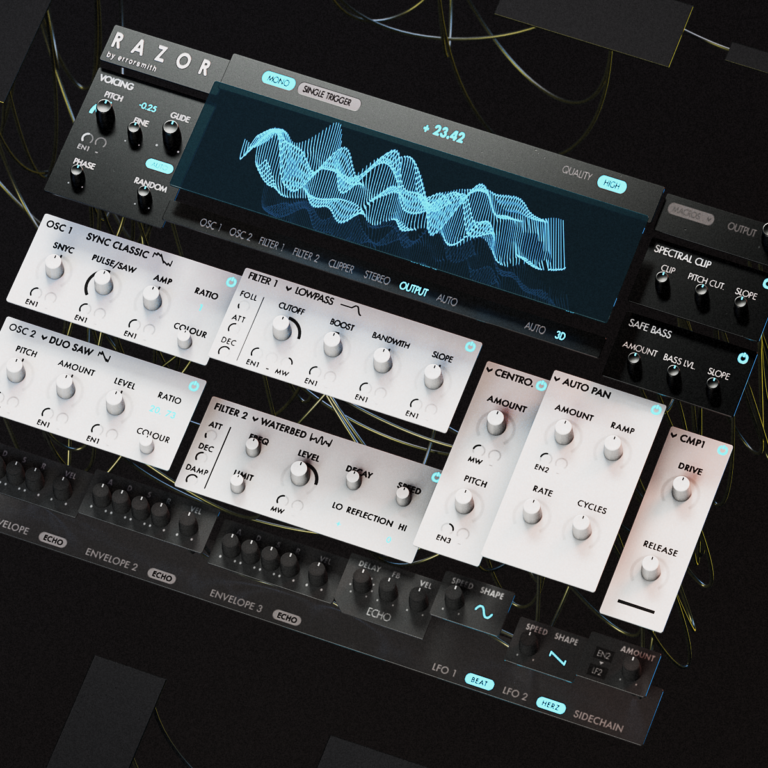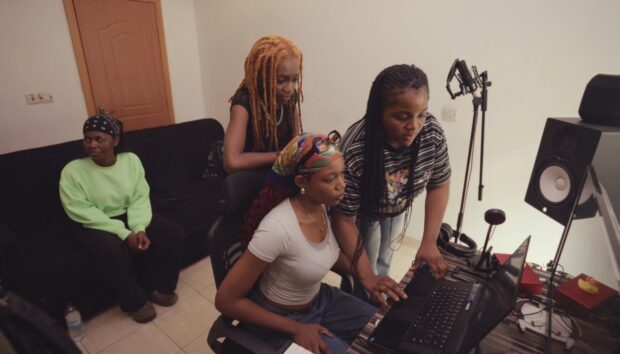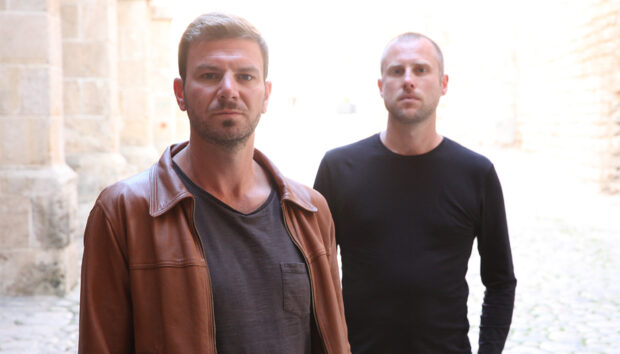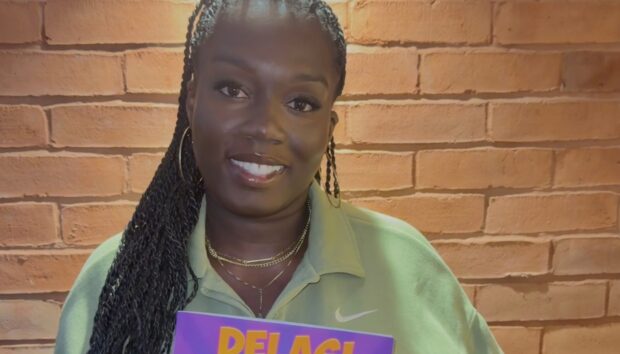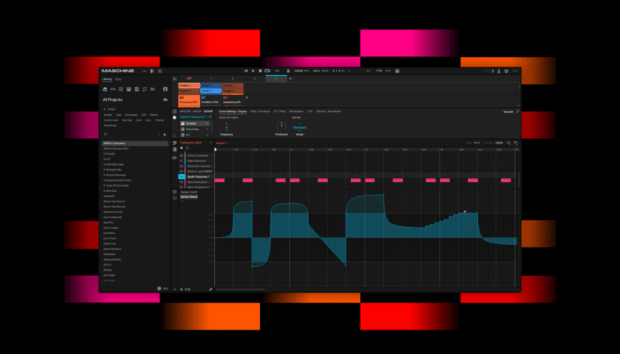“When we use a software synthesizer, we mostly go for Razor,” German duo Modeselektor told us a couple of years ago. “It is still the best sounding software synth ever.” In the fast moving world of digital production, there’s something about Razor, the additive soft synth developed by Errorsmith in collaboration with NI, that has kept producers coming back.
Maybe it’s the fresh take on additive synthesis: its 320-partial engine offers searing sonic clarity, while a friendly interface keeps things from getting too technical. Crucially, almost all of its processing – filters, reverbs, and so on – is achieved through shaping the synth’s constituent partials, leading to some truly unique sonic outcomes. Paired with powerful fine-tuning features – did somebody say Safe Bass? – the synth has found a home in chart pop productions, big-room rave tunes, and cutting edge sound design alike. On the occasion of its tenth anniversary, here’s a look back at some of the music that Razor has inspired.
Dua Lipa – New Rules
Razor can be wild, sure, but it can also be smooth and controlled – and it’s this quality which appeals to producer Ian Kirkpatrick. “It gives you the most control for bass“, he has enthused, describing it as a “must-have” synth. Partly this is down to that ultra-clean additive synthesis; in particular, he credits the Spectral Clip module for giving him finer control over harmonic balance.
Razor’s precision is on display in this Kirkpatrick-produced track for UK star Dua Lipa. Mostly playing a supporting role in the full-spectrum pop arrangement, the bass leaps into the foreground in the verses for a series of lithe, precise pitch bends which steal the show.
Mark Fell – Materialisation epic razor chord and LatelyBass version with found voice
Helpfully for the sound-spotters among us, the track titles on Mark Fell’s 2011 album Manitutshu often list the tools used in their creation. Razor pops up several times – in this case, pointing us to the chords which billow out behind the track’s sharp synth stabs.
Manitutshu is probably one of the earliest records to feature Razor; Fell was invited to develop a set of presets for the synth’s launch, which weren’t ultimately used. It makes sense that the synth found a place in Fell’s music. The Sheffield producer has long balanced an avant-garde sensibility with dazzling sonic clarity. When pushed to its extremes, Razor does just that.
Rian Treanor – Obstacle 4
If Fell’s Manitutshu was one of Razor’s earliest recorded uses, then “Obstacle 4” – released in February by Rian Treanor, Fell’s son and an electronic envelope-pusher in his own right – must be one of its most recent. As with Fell, Razor feels like a natural fit for Treanor’s sound – though in this case, the synth’s ravier side is evident.
Everything but the drums here was made using Razor. The giveaway is the glassy, detuned decays, which manage to sound chaotic and controlled at the same time. Even as the track gets increasingly washed out and diffuse, its angles remain clean and – well, sharp. It’s called Razor for a reason.
Kendrick Lamar – Money Trees (feat. Jay Rock)
Razor’s distinctive qualities often make it a “feature” instrument: when it’s playing, you know it, and Razor watchers come to recognise its telltale sonic signature. But when necessary it can play a subtler role, adapting to functional production tasks.
Just so with this DJ Dahi-produced track. Though not confirmed, online trainspotters have suggested that Dahi used Razor’s “Caffeteria” preset for the bassline here, and we think they’re on the money. Its job is to put a gentle twist on the classic 808 bass sound, and it does so neatly and unfussily, striking a balance between weight and precision.
Fever Ray – Wanna Sip
There’s something about Razor’s bold, full-frequency sound which provokes complicated feelings. When pushed to the max, it can sound seriously aggressive, but there’s also a cartoonish quality to its garish tones. The mixture of threat and humour is key to this 2018 track from Fever Ray, co-produced by Swedish studio chameleon Peder Mannerfelt.
The song’s lyrics, depicting romance as conflict and desire as “a toxic habit”, are underscored by the noxious klaxons which streak through the refrain. But it’s not all doom and gloom: the tones sometimes drop off in a rubbery pitch-bent tail, softening the mood with a hint of playfulness.
Rrose – Waterfall
We’ve heard demonstrations of Razor’s precision, aggression, and downright strangeness; Rrose casts it in a different light. The US producer approaches techno as hypnosis, excavating the richness buried in simple sounds and putting psychoacoustic phenomena in a techno frame.
Thanks to its “insane spectrum of overtones”, as the artist put it in an interview, Razor makes for rich source material.
Razor is the basis of the track’s central loop: those filtered tones which build from subtle undulations into cresting waves of sound. The whole part is built out of just one half-bar sample, recorded from the synth and then sculpted and developed through further processing.
Caterina Barbieri – Fantas
Italian synthesist Caterina Barbieri shuttles between the analogue and digital domains according to her needs. She’s probably best known for rocking a modular setup, but in an interview with us she described using Razor in a piece for the 4DSOUND system, crediting its “mathematical, high-resolution precision” for taking her to places not reachable by analog means.
She’s also integrated Razor into her previously modular-based live setup, and “Fantas”, the standout track from 2019 album Ecstatic Computation, was a product of this. As she explained, “Razor felt like the best instrument to do [Fantas] for its sharp audio synthesis and its powerful control capabilities.” You can see what she means listening to the track’s central arp, which ducks, glides and shifts in timbre over an engrossing ten minutes.
Second Woman – 200601je6
Second Woman’s Josh Eustis and Turk Dietrich believe in keeping their production setup limited – better to dig deep into a single synth than skip between tools. Razor is firmly in their toolbox, having appeared, in some form or other, on most of their tracks.
One of its most striking applications is in “200601je6”, from the duo’s 2016 debut album. Stuttering and hypnotic, the track gives Razor a serious workout, showing both the cleanliness of its articulation and its potential expressive range. Modulated externally using Max For Live, it spits out complex textures in not-quite-graspable rhythms. The duo see the track as “a really fun proof of concept for us to see how far we could take Razor.”
Le Dom – Blossom
It would be remiss to compile a list of Razor-featuring tracks without featuring some full-on rave gear. Many club scenes of the past decade have built Razor into their music, appreciating its bold, larger-than-life sound. Bass music producers are particularly drawn to it, not least for its Safe Bass feature, which ensures that, no matter how chaotic and layered your sound gets, it won’t lose that low-end heft.
“Blossom” is a case in point. Le Dom, of France’s Paradoxe Club, takes detuning to an extreme in this riff on 8 bar grime, which sounds huge through a sound system.
Modeselektor feat. Otto Von Schirach – Evil Twin
Another duo of power-users, Modeselektor have estimated that “about 70%” of their tracks feature Razor. It’s tempting to imagine many of their basses starting life there, but on “Evil Twin” another of Razor’s features takes the stage.
The track’s most striking element is its vocal, a spoken word turn from Floridian eccentric Otto Von Shirach. And that vocal – “Evil twin is the master / Everybody has one…” – sounds the way it does thanks to Razor’s vocoder function. The results pay dues to the robotised vox of classic electro funk, with a crisp twist befitting Modeselektor’s 21st century sound.
Errorsmith – Lightspeed
Technically, this is number eleven but no list celebrating Razor would be complete without a spot from the synth’s creator. In many ways Razor’s sound and approach mirror the musical ethos of Errorsmith, a veteran producer whose music balances daring and playfulness in unique ways. His 2017 album Superlative Fatigue heavily featured the synth, showcasing many of its weird and wonderful capabilities.
On “Lightspeed”, Errorsmith puts the vowel filter through its paces, moulding a single repeating sound into an ingenious robot scat solo which just gets sillier as the track progresses. Errorsmith says it was the (sometimes not so) subtle application of pitch bend that took the longest to perfect. “It’s amazing how much influence it has on our ability to recognize if a sound is more real, or more robotic. I spent quite a bit of time to get that sounding right.”
Don’t miss our recent interview with Errorsmith, reflecting on Razor’s creation and subsequent success. He’s even supplied an exclusive pack of free presets for the occasion, each designed to demonstrate some of his favorite features.








